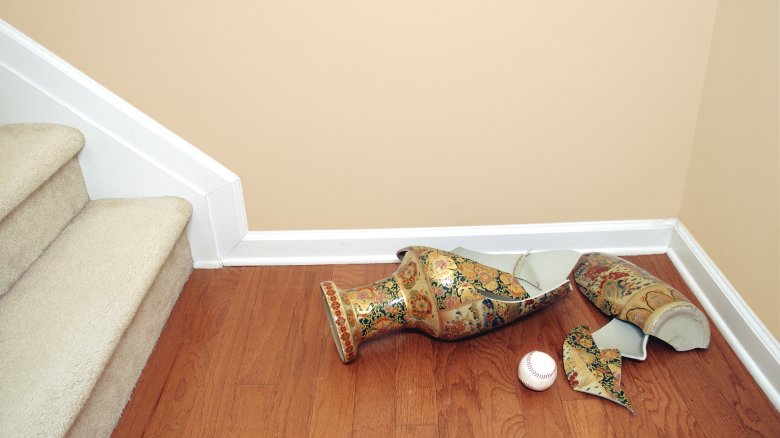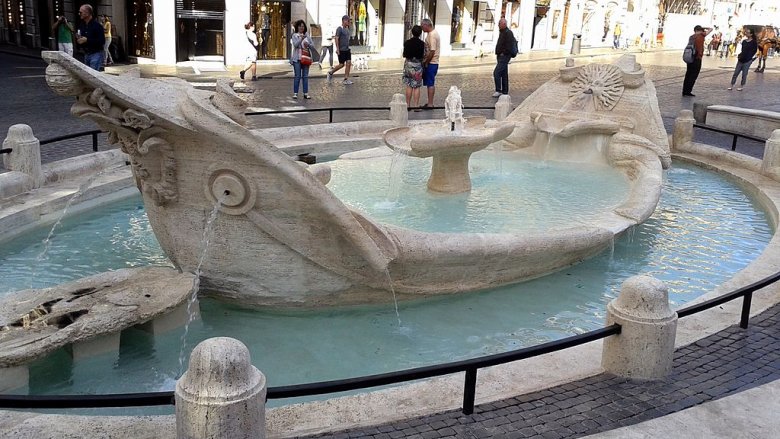The Most Expensive Things Tourists Have Destroyed
It's hard being a tourist. You're in an unfamiliar city or country, maybe you don't speak the language, and you're trying to cram in all the must-see things before you drop from exhaustion. This usually involves seeing famous works of art, some statues, maybe a fountain or two. And for most people this works out fine. They come, they see, they leave everything intact. But then there are the other tourists. Maybe bad luck follows them around or maybe they just have one blazing moment of stupidity, but no matter what, they leave damage in their wake. Expensive damage.
Vandal punches a 10 million euro Monet
The best art divides people. You look at it and you feel something, whether admiration for the work, or a sense of calm, or even anger. Art should bring out an emotion in you or it isn't really doing its job. When this happens, though, it's important not take that emotion out on the artwork itself. If you love it, you should refrain from French kissing it. If you hate it, there's a very clear rule: do not punch the art. You would think that's obvious, but maybe they should start hanging signs saying it in museums. Because at least one person needed to be reminded.
According to the Irish Examiner, the Claude Monet painting "Argenteuil Basin With A Single Sailboat," which was worth 10 million euros before the damage, was just hanging on a wall in the National Gallery of Ireland minding its own business when some guy came along and punched it in 2012. The resulting damage was three huge rips, which Artnet says covered a quarter of the painting.
The restoration was painstaking and took 18 months total. It involved sewing tiny threads of canvas back together and reattaching hundreds of microscopic pieces of paint. Meanwhile the culprit was tried on vandalism charges.
Just in case any copycat vandals decide they, too, suddenly hate Impressionist depictions of sailboats, the painting is now housed behind protective glass.
Man trips and smashes three valuable Chinese vases
Everyone has had a moment when they suddenly seem to lose control of their body and take an embarrassing fall. If you're lucky, you don't break your neck and no one sees you. But sometimes disaster strikes at the worst possible moment.
That's what happened to one man in 2006 when he was visiting the Fitzwilliam Museum in Cambridge, England. According to The Guardian, he was walking down the stairs when he tripped on an untied shoelace and went hurtling toward three Chinese vases from the Qing dynasty that were worth 500,000 pounds. It didn't help that there were no handrails on the stairs, so the poor guy had no way to catch himself. He hit the first vase, which caused a domino effect of one smashing into the next until they were all in pieces. Amazingly, the man was unhurt.
A museum employee defended the choice to put expensive vases at the bottom of a stairwell, saying they had been sitting there for decades and there had never been a problem before. A restorer was contracted to put the more than 400 pieces back together, and the museum was optimistic about getting the vases back on display.
In what seems like a pretty unfair move if it was just an accident, the man was not only banned from the museum, but was eventually held on charges of causing criminal damage.
Taking selfies destroys everything
The older generations may mock millennials for their selfie obsession, but what's the harm, really? Well, if you're near a priceless work of art, the answer seems to be "plenty." People cannot stop damaging things when they take selfies.
Take this story, recounted by UPI. In 2016, a tourist was visiting Lisbon's National Museum of Ancient Art when he went to take a selfie with a 300-year-old statue of St. Michael. He knocked it over, damaging it so badly it couldn't even be repaired.
According to the New York Times, in 2017 a woman was viewing an installation of modern art where crowns were places on pedestals. She bumped into one while taking a selfie and started a domino effect, causing $200,000 in damage.
It's one thing to have an accident when you're just standing there, but then there are the people who put real effort into their selfies by climbing on the piece of art they want to take a picture with. CNN says that's what happened to a 126-year-old statue of King Sebastian of Portugal, in Lisbon in 2016. A guy clambered up on it to get a better shot and knocked it down, smashing into 12 pieces. And per The Local, there were the guys who climbed on the 300-year-old Statue of the two Hercules in Italy, damaging a marble crown sitting on top. Maybe you don't need a picture of your face with every work of art you come across?
Drunk Dutch soccer hooligans damaged the Fontana della Barcaccia
Soccer fans are probably more passionate about their sport than anyone else in the world. But sometimes this passion spills over into hooliganism, and when that happens, disaster can strike.
In 2015, 7,000 Dutch soccer fans descended on Rome for a match. But NPR says that in the days leading up to it they decided to see the town in their totally drunken hooligan fashion. They took over two famous squares, and shopkeepers literally boarded up their shops and fled. They completely trashed the place, but the worst was they broke the Fontana della Barcaccia, one of Rome's most famous fountains, built in 1627 and which had only recently gone through a restoration. How did they do it? Hundreds of them threw beer bottles full of urine at it. An official said the damage was permanent and 23 Dutch nationals were arrested and looking at jail time. The total cost of all the damage to the squares came to 3 million euros.
At least the game was totally worth all this violent buildup, right? Wrong. It ended in a 1-1 tie.
But the Dutch aren't all bad. According to The Local, one woman heard what happened and started a Go Fund Me campaign to help pay for the damage. Over 300 donations were made in just three days! Sure, they only came to 7,735 euros, but it's the thought that counts. She proved #NotAllDutchPeople are drunken hooligans who don't care about culture.
An American tourist gave the Virgin Mary a high five and broke her hand
Most museums have one simple rule: no touching. There are probably signs and burly guards standing around to make sure you get the point. No matter how cute that painted puppy looks, you can't reach out and pet it. And even if a statue seems to be holding up their hand for a high five, you must resist.
According to NPR, one visitor to the Museo dell'Opera del Duomo in Florence in 2013 just couldn't help himself. He saw a 15th-century Giovanni d'Ambrogio statue of the Virgin Mary holding up her hand and he just couldn't leave her hanging. So he reached out and gave her a high five. (Okay, he was really comparing hand spans, but that's less fun.) Either way, her pinky finger went flying off. The finger he broke off was actually already a replacement — the original had broken off long ago — but still, that kind of defeats the point of the repair.
The BBC says the 55-year-old Missouri man apologized, but he was still facing a fine and was chastised by the museum's director who reminded him about that whole "no touching" thing.
Perhaps the most supreme irony is that The Local reported he was actually a surgeon. Aren't they like, supposed to do things like reattach fingers, not break them off their patients' bodies?
Two schoolboys break the Elgin Marbles
You might not be aware of just how controversial the Elgin Marbles are. Located in the British Museum, they are the frieze of the Parthenon in Greece. So why does the U.K. have them? Because there was a point in British history where they just ran around the world taking whatever they wanted. And in the early 1800s, Lord Elgin decided he wanted the frieze of the Parthenon. The museum still has the marbles today, but Greece isn't happy about it and has demanded them back many times.
One of the arguments the British Museum makes for why they should get to keep them is that they can take better care of these priceless works of art. The problem is, papers released in 2005 show that under the museum's watch, the marbles have been damaged countless times, by visitors and even staff.
The Telegraph revealed one highlight from 1961. Two young boys were on a school trip to the museum when they started fighting. You would have killed to go on such a cool class trip as a kid, right? Instead you probably went to the firehouse, or a landfill, or the local butcher because it's never too early to find out the harsh reality that animals die. But these boys didn't appreciate that and started shoving each other. One of them fell into a marble centaur and knocked its leg off. While it was reattached, it was permanently damaged.
A woman rips a $100 million Picasso
Pablo Picasso is maybe the most famous painter ever, and his works are worth obscene amounts of money. That's why it was so tragic when one of his earliest paintings, "The Actor," was damaged in an accident. Before the damage, it was worth an estimated $100 million.
According to the New York Times, "The Actor" had been hanging on the walls of the Metropolitan Museum of Art since 1952 with no issues. But then someone decided it would be a good idea to start doing adult education classes at the Met, and they didn't screen the participants for clumsiness before starting. That's why one woman who was standing next to the 105-year-old painting in 2010 managed to trip and make a 6-inch rip.
Perhaps the weirdest thing about this damage was that it ended up on Craigslist Close Encounters. No one knows if it was a joke or not, but the person who wrote it claimed to be the same one who tore the painting. She says she met a guy in the elevator going to the second floor. They had a bit of a flirty smile thing going on and she saw him again in the Cubist section. Right as she was getting up the courage to go talk to him, disaster struck. She ripped the painting and ruined her chance at love. She helpfully adds that if he sees the story on the news the next day, that was her. Maybe her $100 million mistake had a happy ending.
Pont des Arts bridge collapses under the weight of 'love locks'
Paris is the city of love, so it makes sense that if you traveled there with your significant other, you'd want to do something to show how in love you are. And what better represents how you're going to be together forever, never able to escape the relationship no matter how hard you try, than a padlock? Why not take one of those bad boys, write your initials on it, and attach it to the railing of a bridge? It's not clear who first came up with this idea sometime in 2009, but thousands of people thought it was brilliant and followed suit.
Soon the Pont des Arts, a 200-year-old bridge built way back when Napoleon was in charge, was covered in these so called "love locks." Enterprising salespeople even popped up in the area, so if you didn't come prepared you could still join in the fun. According to the Telegraph, couples would throw the key into the Seine after attaching the lock to the railing, you know to show their commitment. It's kind of cute, but padlocks aren't exactly light. And City Metric says that within five years there were 45 tons of them.
The inevitable happened in 2014 when a section of the bridge collapsed and had to be replaced with wooden panels. Soon the love locks were removed, and all those couples probably immediately broke up.
Visitor tries to start a clock, breaks it
When you go to a clock museum, you expect to see a lot of clocks. Big clocks, small clocks, analog clocks, digital clocks. But they key thing that makes a clock is its ability to tell time, and for that it needs to be running. You might feel understandably short-changed if you went to a clock museum and some of them had stopped.
According to Atlas Obscura, one man who went to the National Watch and Clock Museum wasn't having any of this stopped-clock nonsense, so he was caught on their security cameras doing something really stupid. He walks up to a clock hanging on the wall and takes a picture. But then he decided he is going to try and make it run. This particular clock was also a piece of abstract art, so it wasn't exactly clear how to make it go. His companion helpfully points out a hanging bit and he pulls on it. Nothing. So he moves another piece. He keeps messing with it until it does seem to start. But he doesn't let well enough alone and keeps poking and prodding. And then it falls off the wall. Pieces scatter across the floor and are quickly gathered up by his companion while he tries to put the main bit back on the wall. Failing that, he leans it on the wall, probably hoping no one will notice what happened. It's abstract art right? It's supposed to look weird.
An anonymous drunk party-goer broke some modern art
Art museums aren't exactly known as being the most hip, happening places to be, so if you want to make your latest viewing a must-see event, you need to add something special. Something like alcohol! People love alcohol. Artnet says that the yearly show Art Basel (located in the party city of Miami for good measure) figured that out. But you can probably see the immediate problem here. People can easily break things while they're stone-cold sober. Add booze and you're asking for trouble.
Amazingly, there seem to only have been one time when there was a disaster, but it was one absolutely everyone should have seen coming. According to the Miami Herald, at the Pérez Art Museum in 2014, there was a display of 12 concrete orbs, each with a beach towel inside them. They were on the floor, and there was no guard rail or anything to stop people from walking around them, or through them, or even straight into them if they felt like it.
So of course, some unknown vandal, who was probably pretty drunk, managed to break some of them. Remember, this is concrete we're talking about, so it must have taken some effort. Maybe they were dancing around to whatever tunes the DJ was spinning and had an accident. Regardless, many were rolled out of place and one was broken completely in half.









